MERCEDES-BENZ C-Class COUPE 2017 CL205 Owner's Manual
Manufacturer: MERCEDES-BENZ, Model Year: 2017, Model line: C-Class COUPE, Model: MERCEDES-BENZ C-Class COUPE 2017 CL205Pages: 354, PDF Size: 8.66 MB
Page 151 of 354
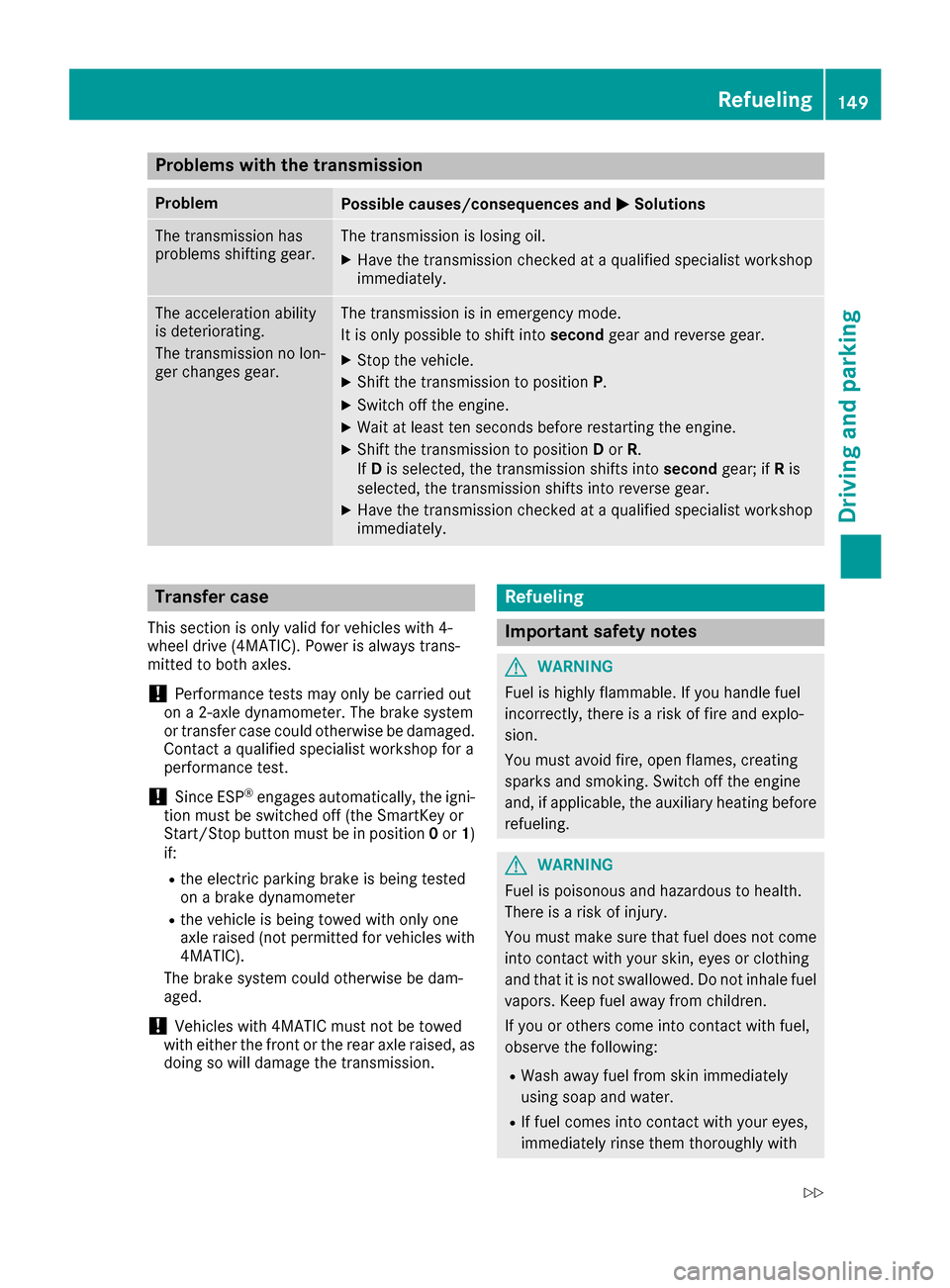
Problems with the transmission
ProblemPossible causes/consequences andMSolutions
The transmission has
problems shifting gear.The transmission is losing oil.
XHave the transmission checked ataqualified specialist workshop
immediately.
The acceleration ability
is deteriorating.
The transmission no lon-
ger changes gear.The transmission is in emergency mode.
It is only possible to shift into secondgear and reverse gear.
XStop the vehicle.
XShift the transmission to position P.
XSwitch off the engine.
XWait at least ten seconds before restarting the engine.
XShift the transmission to positionDor R.
If D is selected, the transmission shifts into secondgear; ifRis
selected, the transmission shifts into reverse gear.
XHave the transmission checked at aqualified specialist workshop
immediately.
Transfer case
This section is only valid for vehicles with 4-
wheel drive (4MATIC). Power is always trans-
mitted to both axles.
!Performancet ests may only be carried out
on a2 -axle dynamometer. The brake system
or transfer case could otherwise be damaged. Contact aqualified specialist workshop for a
performancet est.
!Since ESP®engages automatically, the igni-
tion must be switched off (the SmartKey or
Start/Stop button must be in position 0or 1)
if:
Rthe electric parking brake is being tested
on abrake dynamometer
Rthe vehicle is being towed with only one
axle raised (not permitted for vehicles with
4MATIC).
The brake system could otherwise be dam-
aged.
!Vehicles with 4MATIC must not be towed
with either the front or the rear axle raised, as doing so will damage the transmission.
Refueling
Important safety notes
GWARNING
Fuel is highly flammable. If you handle fuel
incorrectly, there is arisk of fire and explo-
sion.
You must avoid fire, open flames, creating
sparks and smoking. Switch off the engine
and, if applicable, the auxiliary heating before refueling.
GWARNING
Fuel is poisonous and hazardous to health.
There is arisk of injury.
You must make sure that fuel does not come into contact with your skin, eyes or clothing
and that it is not swallowed. Do not inhale fuel
vapors. Keep fuel away from children.
If you or others come into contact with fuel,
observe the following:
RWash away fuel from skin immediately
using soap and water.
RIf fuel comes into contact with your eyes,
immediately rinse them thoroughly with
Refueling149
Driving and parking
Z
Page 152 of 354
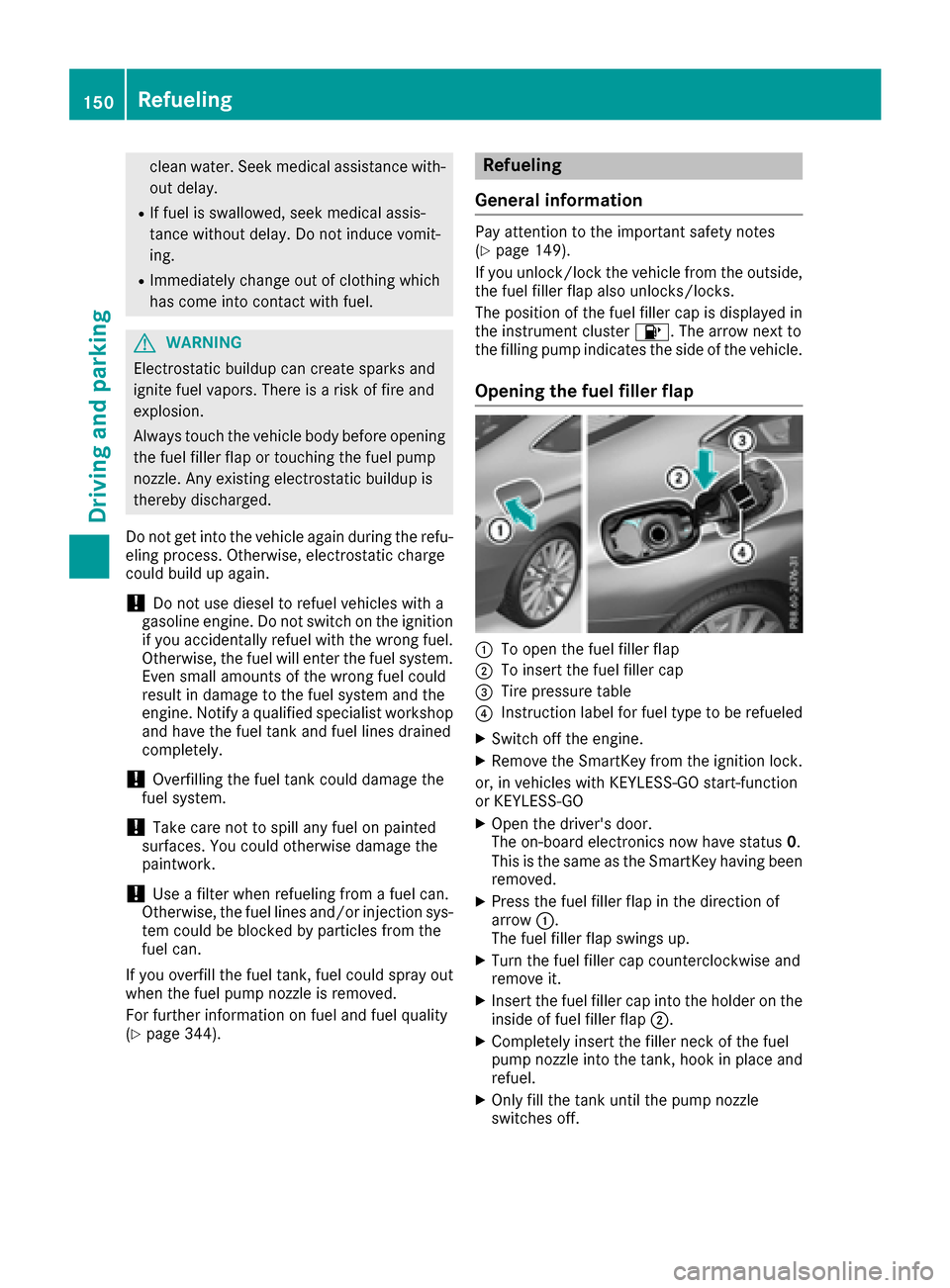
clean water. Seek medicalassistance with-
outd elay.
RIf fuelisswallowed, seekm edicalassis-
tance withou tdelay .Don ot induce vomit-
ing.
RImmediatel ychange outofc lothing which
hasc ome into contact with fuel.
GWARNING
Electrostati cbuildup can create sparks and
ignite fue lvapors. There is ariskoff ire and
explosion.
Alway stouch the vehicle bod ybefore opening
the fue lfille rflaport ouching the fue lpum p
nozzle .Any existing electrostatic buildupi s
thereby discharged.
Do not get into the vehicle agai nduring the refu-
eling process .Otherwise, electrostatic charge
could buil dupagain.
!Do not us edieseltor efuel vehicle switha
gasoline engine. Do not switch on the ignition
if yo uaccidentall yrefuel with the wrong fuel.
Otherwise, the fue lwille nter the fue lsys tem.
Even small amounts of the wrong fue lcould
result in damag etothe fue lsystem and the
engine. Notify aquali fied specialist workshop
and have the fue ltank and fue llin es drained
completely.
!Overfilling the fue ltank could damag ethe
fue lsystem.
!Take care not to spill any fue lonpainted
surfaces. You could otherwise damag ethe
paintwork.
!Use afilter whe nrefueling from afuelcan.
Otherwise, the fue llin es and/or injection sys-
tem could be blocked by particles from the
fue lcan.
If yo uoverfil lthe fue ltank, fue lcould spra yout
whe nthe fue lpum pnozzle is removed.
For further information on fue land fue lquali ty
(
Ypage 344).
Refueling
General information
Paya ttention to the important safety notes
(Ypage 149).
If yo uunlock/lock the vehicle from the outside,
the fue lfille rflapa lsou nlocks/locks.
The position of the fue lfille rcap is displayed in
the instrument cluster 8.The arrow next to
the filling pump indicates the sid eofthe vehicle.
Opening the fuel fille rflap
:To ope nthe fue lfille rflap
;To insert the fue lfille rcap
=Tirep ressure table
?Instruction label for fue ltyp etober efueled
XSwitch off the engine.
XRemove the SmartKey from the ignition lock.
or, in vehicle swithK EYLESS-G Ostart-function
or KEYLESS ‑GO
XOpenthe driver' sdoor.
The on-board electronics now have status 0.
Thi sist he sam easthe SmartKey having been
removed.
XPress the fue lfille rflapint he direction of
arrow :.
The fue lfille rflaps wings up.
XTurn the fue lfille rcap counterclockwise and
remove it.
XInser tthe fue lfille rcap into the holder on the
inside of fue lfille rflap ;.
XCompletel yinsert the fille rneck of the fuel
pump nozzle into the tank, hookinp lace and
refuel.
XOnly fil lthe tank untilt he pump nozzle
switches off.
150Refueling
Drivin gand parking
Page 153 of 354
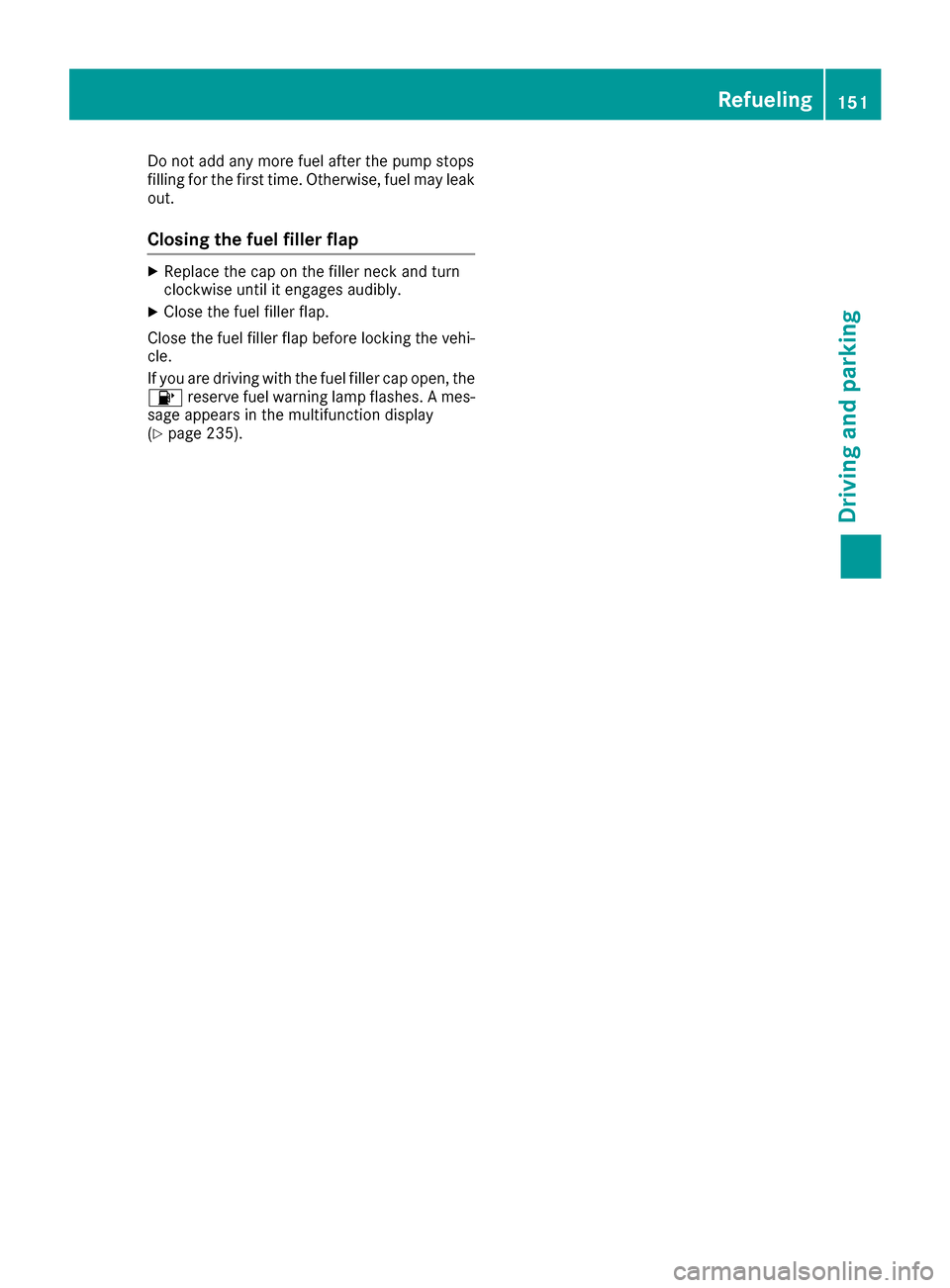
Do not addany mor efuelafter the pump stops
filling for the first time .Otherwise, fuel mayl eak
out.
Closin gthe fuelf illerflap
XReplace the cap on the fille rneck and turn
clockwise unti litengages audibly.
XClose the fuel fille rflap.
Close the fuel fille rflapb efor el oc king the vehi-
cle.
If yo uaredrivin gwitht he fuel fille rcap open, the
8 reserv efuelw arning lamp flashes. Ames-
sage appear sinthe multifunctio ndisplay
(
Ypage 235).
Refueling151
Driving an dparking
Z
Page 154 of 354
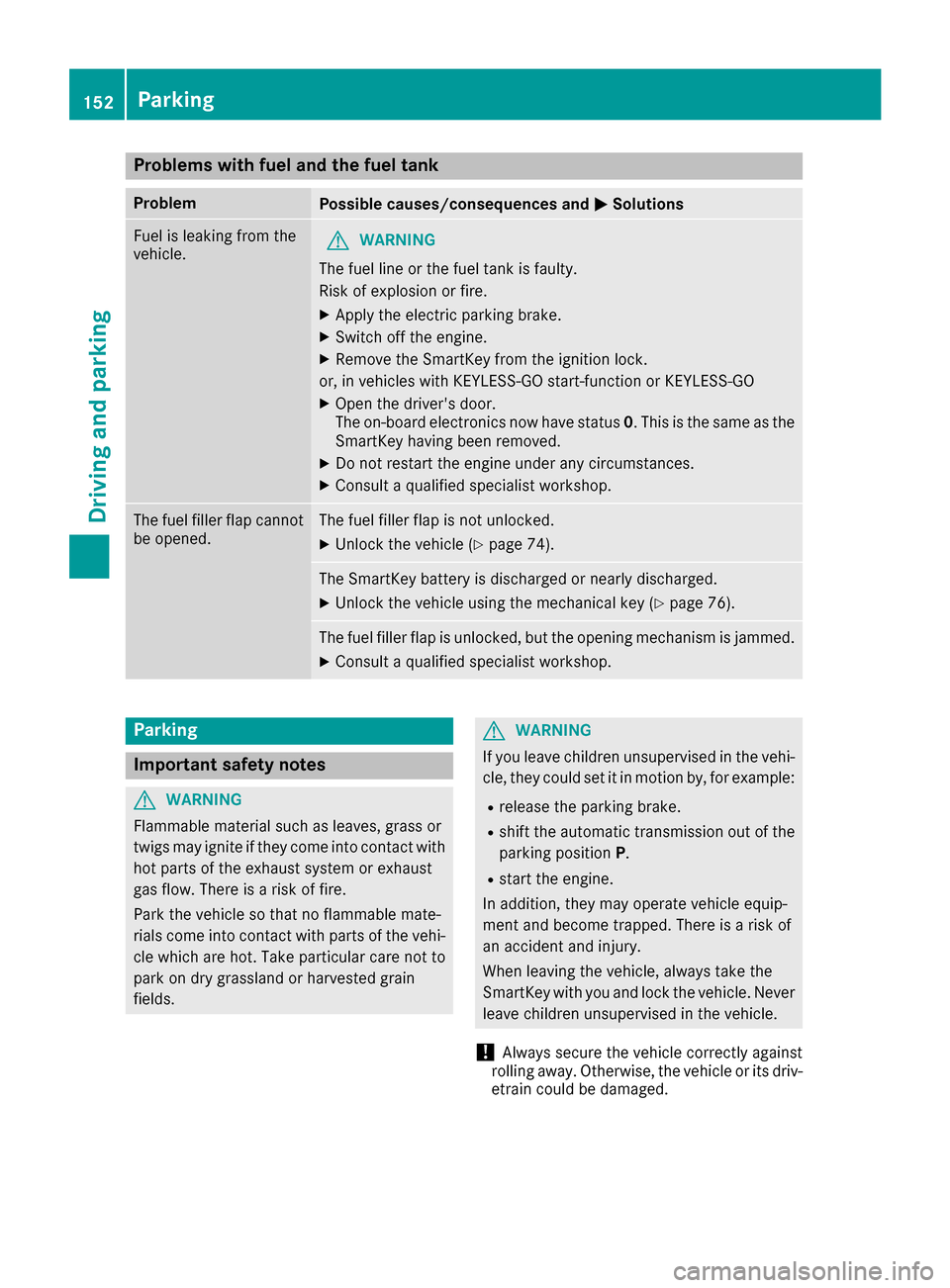
Problems with fuel and the fuel tank
ProblemPossible causes/consequences andMSolutions
Fuel is leaking from the
vehicle.GWARNING
The fuel line or the fuel tank is faulty.
Risk of explosion or fire.
XApply the electric parking brake.
XSwitch off the engine.
XRemove the SmartKey from the ignition lock.
or, in vehicles with KEYLESS-GO start-function or KEYLESS ‑GO
XOpen the driver's door.
The on-board electronics now have status0.This is the same as the
SmartKey having been removed.
XDo not restart the engine under any circumstances.
XConsult aqualified specialist workshop.
The fuel filler flap cannot
be opened.The fuel filler flap is not unlocked.
XUnlock the vehicle (Ypage 74).
The SmartKey battery is discharged or nearly discharged.
XUnlock the vehicle using the mechanical key (Ypage 76).
The fuel filler flap is unlocked, but the opening mechanism is jammed.
XConsult aqualified specialist workshop.
Parking
Important safety notes
GWARNING
Flammable material such as leaves, grass or
twigs may ignite if they come into contact with
hot parts of the exhaust system or exhaust
gas flow. There is arisk of fire.
Park the vehicle so that no flammable mate-
rials come into contact with parts of the vehi-
cle which are hot. Take particular care not to
park on dry grassland or harvested grain
fields.
GWARNING
If you leave children unsupervised in the vehi-
cle, they could set it in motion by, for example:
Rrelease the parking brake.
Rshift the automatic transmission out of the
parking position P.
Rstart the engine.
In addition, they may operate vehicle equip-
ment and become trapped. There is arisk of
an accident and injury.
When leaving the vehicle, always take the
SmartKey with you and lock the vehicle. Never
leave children unsupervised in the vehicle.
!Always secure the vehicle correctly against
rolling away.O therwise, the vehicle or its driv-
etrain could be damaged.
152Parking
Driving and parking
Page 155 of 354
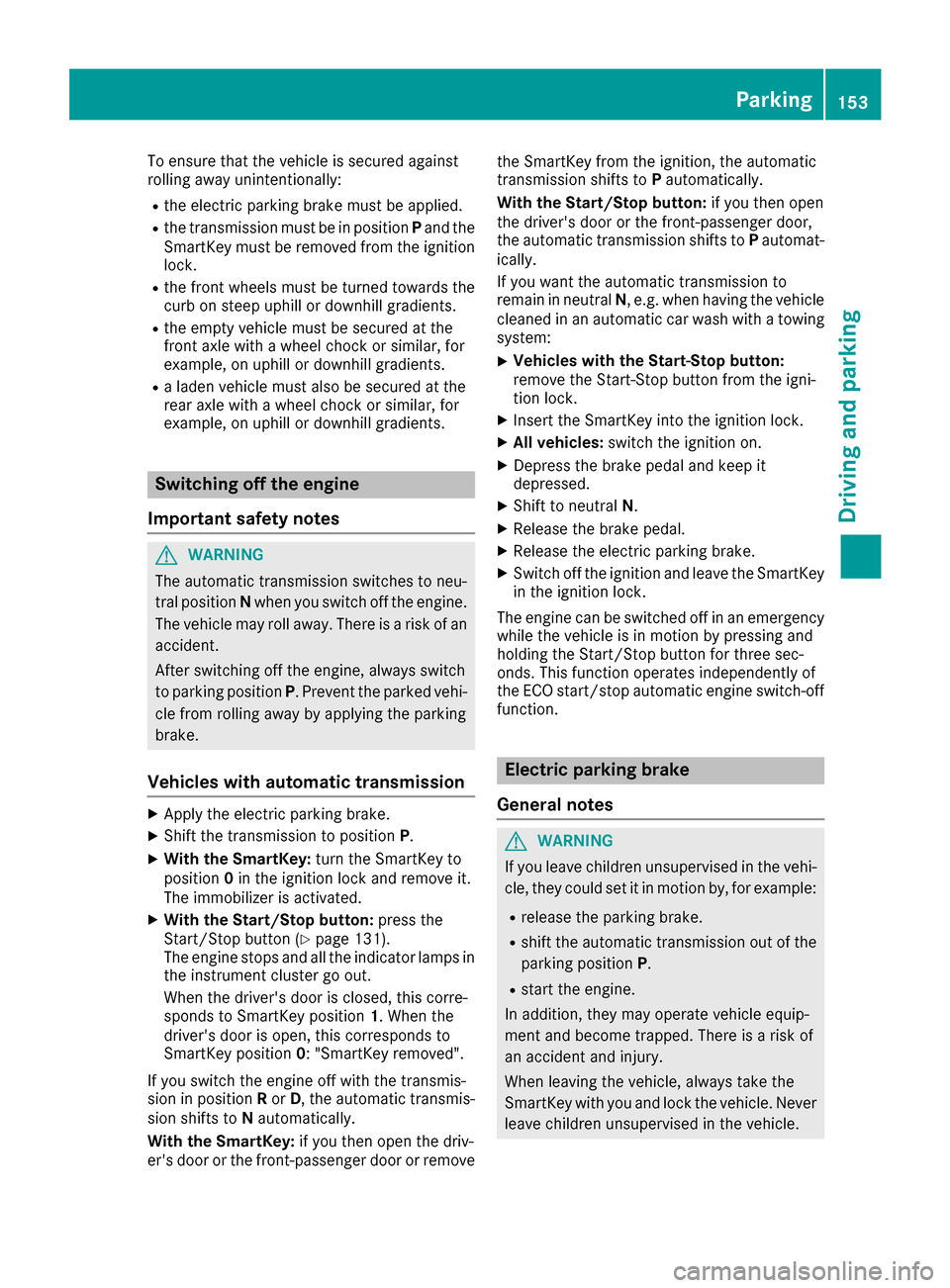
To ensure that the vehicle is secured against
rolling away unintentionally:
Rthe electric parking brake must be applied.
Rthe transmission must be in positionPand the
SmartKey must be removed from the ignition
lock.
Rthe front wheels must be turned towards the
curb on steep uphill or downhill gradients.
Rthe empty vehicle must be secured at the
front axle with awheel chock or similar, for
example, on uphill or downhill gradients.
Ral aden vehicle must also be secured at the
rear axle with awheel chock or similar, for
example, on uphill or downhill gradients.
Switching off the engine
Important safety notes
GWARNING
The automatic transmission switches to neu-
tral position Nwhen you switch off the engine.
The vehicle may roll away.T here isarisk of an
accident.
After switching off the engine, alwayss witch
to parking position P.Prevent the parked vehi-
cle from rolling away by applying the parking
brake.
Vehicles with automatic transmission
XApply the electric parking brake.
XShift the transmission to position P.
XWith the SmartKey:turn the SmartKey to
position 0in the ignition lock and remove it.
The immobilizer is activated.
XWith the Start/Stop button: press the
Start/Stop button (Ypage 131).
The engine stops and all the indicator lamps in
the instrument cluster go out.
When the driver's door is closed, this corre-
sponds to SmartKey position 1.When the
driver's door is open, this corresponds to
SmartKey position 0:"SmartKey removed".
If you switch the engine off with the transmis-
sion in position Ror D,t he automatic transmis-
sion shifts to Nautomatically.
With the SmartKey: if you then open the driv-
er's door or the front-passenger door or remove the SmartKey from the ignition, the automatic
transmission shifts to
Pautomatically.
With the Start/Stop button: if you then open
the driver's door or the front-passenger door,
the automatic transmission shifts to Pautomat-
ically.
If you want the automatic transmission to
remain in neutral N,e .g. when having the vehicle
cleaned in an automatic car wash with atowing
system:
XVehicles with the Start-Stop button:
remove the Start-Stop button from the igni-
tion lock.
XInsert the SmartKey into the ignition lock.
XAll vehicles: switch the ignition on.
XDepress the brake pedal and keep it
depressed.
XShift to neutral N.
XRelease the brake pedal.
XRelease the electric parking brake.
XSwitch off the ignition and leave the SmartKey
in the ignition lock.
The engine can be switched off in an emergency
while the vehicle is in motion by pressing and
holding the Start/Stop button for three sec-
onds. This function operates independently of
the ECO start/sto pautomatic engine switch-off
function.
Electric parking brake
General notes
GWARNING
If you leave children unsupervised in the vehi-
cle, they could set it in motion by, for example:
Rrelease the parking brake.
Rshift the automatic transmission out of the
parking position P.
Rstart the engine.
In addition, they may operate vehicle equip-
ment and become trapped. There is arisk of
an accident and injury.
When leaving the vehicle, alwayst ake the
SmartKey with you and lock the vehicle. Never
leave children unsupervised in the vehicle.
Parking153
Driving and parking
Z
Page 156 of 354
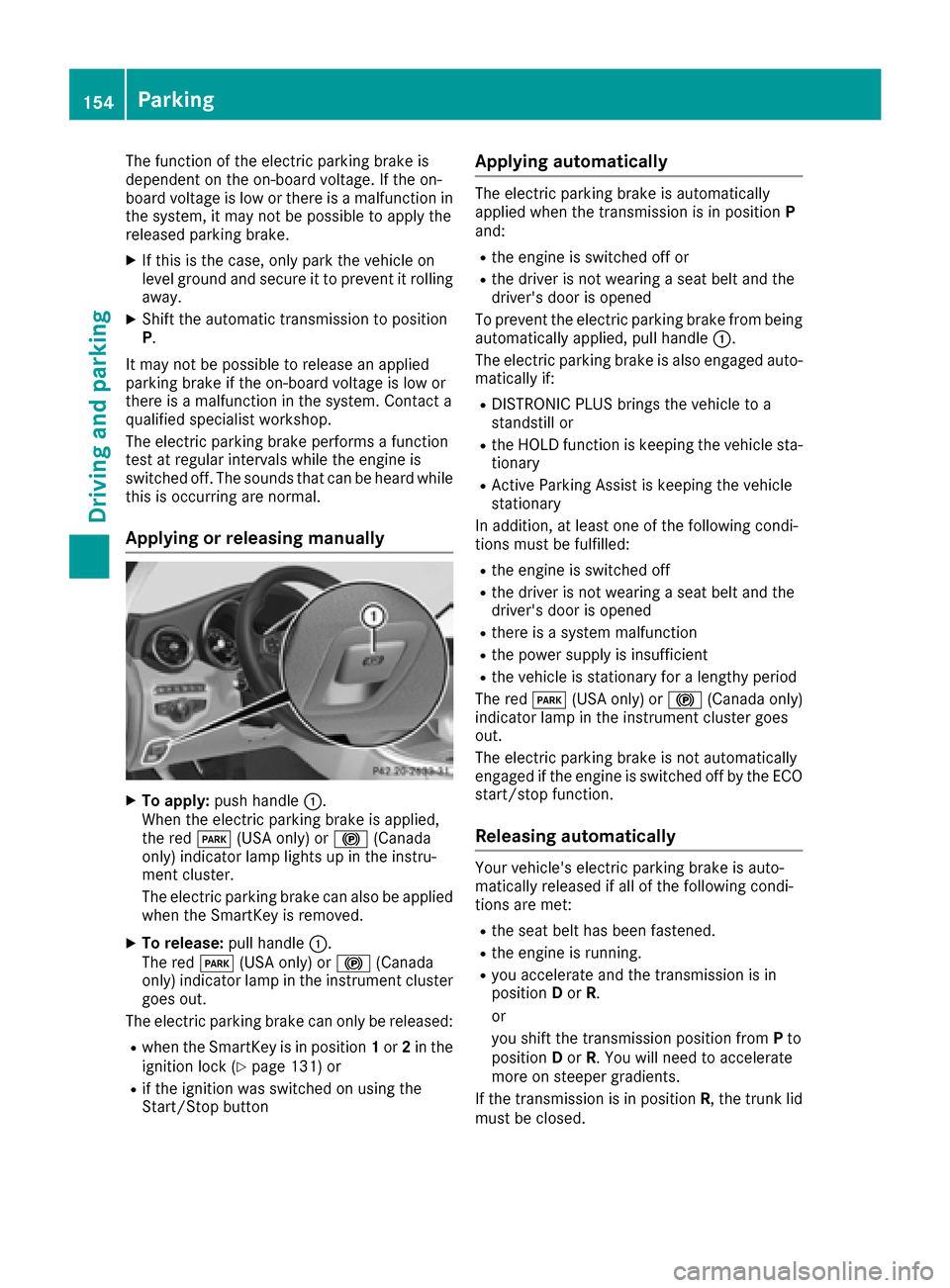
The function of the electric parking brake is
dependent on the on-board voltage. If the on-
board voltage is low or there isamalfunction in
the system, it may not be possible to apply the
released parking brake.
XIf this is the case, only park the vehicle on
level ground and secure it to prevent it rolling
away.
XShift the automatic transmission to position
P.
It may not be possible to release an applied
parking brake if the on-board voltage is low or
there is amalfunction in the system. Contact a
qualified specialist workshop.
The electric parking brake performs afunction
test at regular intervals while the engine is
switched off. The sounds that can be heard while
this is occurringa re normal.
Applying or releasing manually
XTo apply:push handle :.
When the electric parking brake is applied,
the red F(USA only) or !(Canada
only) indicator lamp lights up in the instru-
ment cluster.
The electric parking brake can also be applied
when the SmartKey is removed.
XTo release: pull handle:.
The red F(USA only) or !(Canada
only) indicator lamp in the instrument cluster
goes out.
The electric parking brake can only be released:
Rwhen the SmartKey is in position 1or 2in the
ignition lock (Ypage 131) or
Rif the ignition was switched on using the
Start/Stop button
Applying automatically
The electric parking brake is automatically
applied when the transmission is in position P
and:
Rthe engine is switched off or
Rthe driver is not wearing aseat belt and the
driver's door is opened
To prevent the electric parking brake from being automatically applied, pull handle :.
The electric parking brake is also engaged auto-
matically if:
RDISTRONIC PLUS brings the vehicle to a
standstill or
Rthe HOLD function is keeping the vehicle sta- tionary
RActive Parking Assist is keeping the vehicle
stationary
In addition, at least one of the following condi-
tions must be fulfilled:
Rthe engine is switched off
Rthe driver is not wearing aseat belt and the
driver's door is opened
Rthere is asystem malfunction
Rthe power supply is insufficient
Rthe vehicle is stationary for alengthy period
The red F(USA only) or !(Canada only)
indicator lamp in the instrument cluster goes
out.
The electric parking brake is not automatically
engaged if the engine is switched off by the ECO
start/sto pfunction.
Releasing automatically
Your vehicle's electric parking brake is auto-
matically released if all of the following condi-
tions are met:
Rthe seat belt has been fastened.
Rthe engine is running.
Ryou accelerate and the transmission is in
position Dor R.
or
you shift the transmission position from Pto
position Dor R.Y ou will need to accelerate
more on steeper gradients.
If the transmission is in position R,the trunk lid
must be closed.
154Parking
Driving and parking
Page 157 of 354
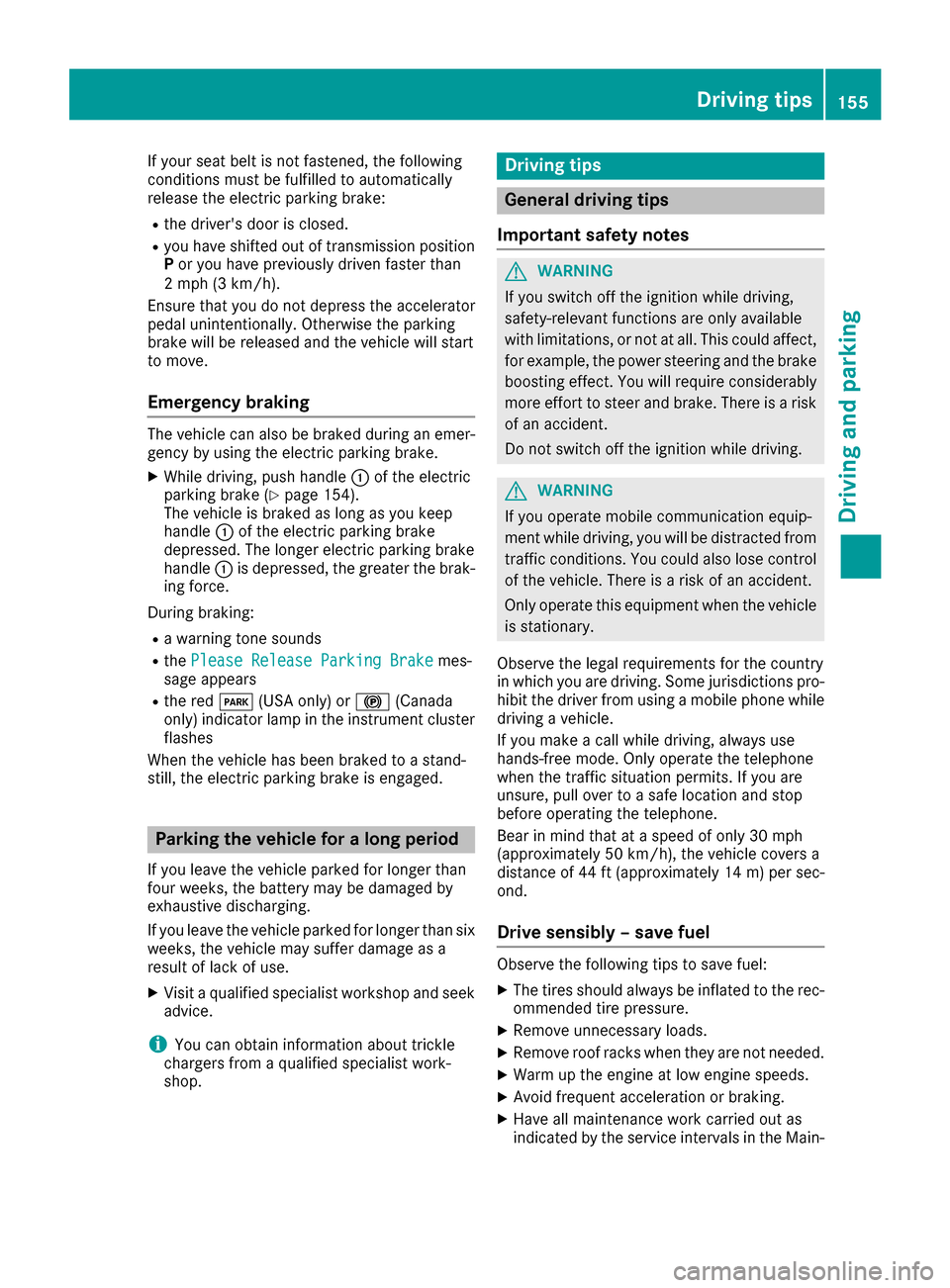
If yourseat belt is not fastened, the following
conditions must be fulfilled to automatically
release the electric parking brake:
Rthe driver's door is closed.
Ryou have shifted out of transmission position
P or you have previously driven faster than
2m ph (3 km/h).
Ensure that you do not depresst he accelerator
pedalu nintentionally .Otherwise the parking
brake wil lbereleased and the vehicle wil lstart
to move.
Emergency braking
The vehicle can also be braked during an emer- gency by using the electric parking brake.
XWhiled riving, push handle :of the electric
parking brake (Ypage 154).
The vehicle is braked as long as you keep
handle :of the electric parking brake
depressed. The longer electric parking brake
handle :is depressed, the greater the brak-
ing force.
During braking:
Raw arning tone sounds
Rthe Please Release Parking Brakemes-
sage appears
Rthe red F(USA only) or !(Canada
only) indicator lamp in the instrument cluster
flashes
When the vehicle has been braked to astand-
still, the electric parking brake is engaged.
Parking the vehicle for alongp eriod
If you leave the vehicle parked for longer than
four weeks, the battery may be damaged by
exhaustive discharging.
If you leave the vehicle parked for longer than six
weeks, the vehicle may suffer damage as a
resultoflack of use.
XVisit aqualifieds pecialist workshop and seek
advice.
iYou can obtain information abou ttrickle
chargers from aqualifieds pecialist work-
shop.
Drivin gtips
General driving tips
Important safety notes
GWARNING
If you switch off the ignition whil edriving,
safety-relevant functions are only available
with limitations, or not at all .This could affect,
for example ,the powers teering and the brake
boosting effect. You wil lrequire considerably
more effort to steer and brake. There is arisk
of an accident.
Do not switch off the ignition whil edriving.
GWARNING
If you operate mobilec ommunication equip-
ment whiled riving, you willbed istracted from
traffic conditions. You could also lose control
of the vehicle.T here isarisk of an accident.
Only operate this equipment when the vehicle
is stationary.
Observe the legalr equirements for the country
in which you are driving. Some jurisdictions pro-
hibitt he driver from using amobilep hone while
driving avehicle.
If you make acall whiled riving, always use
hands-free mode. Only operate the telephone
when the traffic situation permits. If you are
unsure, pul lover to asafe location and stop
before operating the telephone.
Bear in mind that at aspeed of only 30 mph
(approximatel y50km/h), the vehicle covers a
distance of 44 ft (approximatel y14m)p er sec-
ond.
Drive sensibly –save fuel
Observe the following tips to save fuel:
XThe tires should always be inflated to the rec-
ommended tire pressure.
XRemove unnecessary loads.
XRemove roof racksw hen they are not needed.
XWarm up the engineatlow engin espeeds.
XAvoid frequenta cceleration or braking.
XHave all maintenanc ework carried out as
indicated by the servicei ntervals in the Main-
Driving tips155
Driving and parking
Z
Page 158 of 354
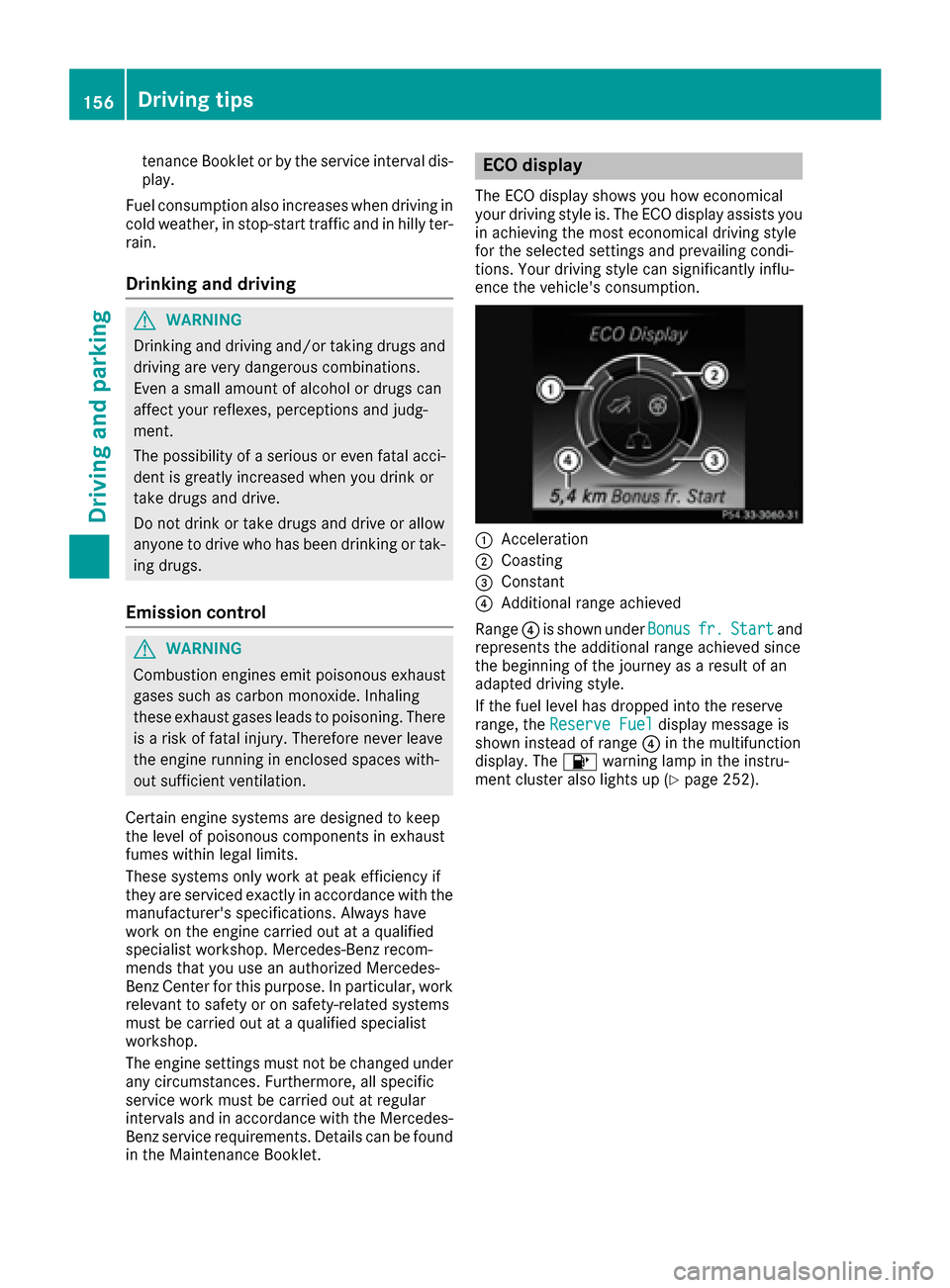
tenance Bookletorbythe service intervald is-
play.
Fue lconsumption also increasesw hend rivin gin
col dw eather, in stop-start traffica nd in hillyter-
rain.
Drinking and driving
GWARNING
Drinking and drivin gand/or taking drugs and
drivin garever ydangerou scombinations.
Even asmall amount of alcohol or drugs can
affect your reflexes ,perceptions and judg-
ment.
The possibility of aserious or eve nfatal acci-
dent is greatl yincreasedw heny ou drink or
take drugs and drive.
Do not drink or take drugs and drive or allow
anyone to drive wh ohasbeen drinking or tak-
ing drugs.
Emissio ncontrol
GWARNING
Combustion engine semitp oiso nous exhaust
gasess uchasc arbonmonoxide. Inhaling
these exhaust gasesl eadsto poisoning. There
is ar iskoff atal injury.T herefore neve rleave
the engine running in enclose dspacesw ith-
ou tsufficient ventilation.
Certain engine systems ar edesig nedtok eep
the level of poisonous components in exhaust
fumes withinl egallimits.
These systems onl yworkatp eake fficiency if
theya reserviced exactly in accordance with the
manufacturer's specifications .Alway shave
work on the engine carrie doutataq uali fied
specialis tworkshop .Mercedes-Benz recom-
mend sthaty ouuseana uthorize dMercedes-
Benz Center for thisp urpose.Inp articular ,work
relevant to safety or on safety-relate dsystems
must be carrie doutataq uali fied specialist
workshop.
The engine setting smustn ot be change dunder
any circumstances .Furthermore, al lspe cific
service work must be carrie doutat regular
intervals and in accordance with the Mercedes-
Benz service requirements .Detail scan be found
in the Maintenanc eBooklet.
ECOd isplay
The ECO displa yshows yo uhow economical
your drivin gstyle is .The EC Odisplay assists you
in achievin gthe mos teconomical drivin gstyle
for the selected setting sand prevailing condi-
tions. Your drivin gstyle can significantl yinflu-
ence the vehicle' sconsumption.
:Acceleration
;Coasting
=Constant
?Additiona lran ge achieved
Range ?is shown under Bonus
fr.Startand
represents the additional range achieved since
the beginning of the journey as aresul tofa n
adapted drivin gstyle.
If the fuel level hasd ropped into the reserve
range ,the Reserv eFuel
displa ymessage is
shown instea dofrange ? in the multifunction
display. The 8warning lamp in the instru-
ment clustera lsol ights up (
Ypage 252).
156Driving tips
Driving an dparking
Page 159 of 354
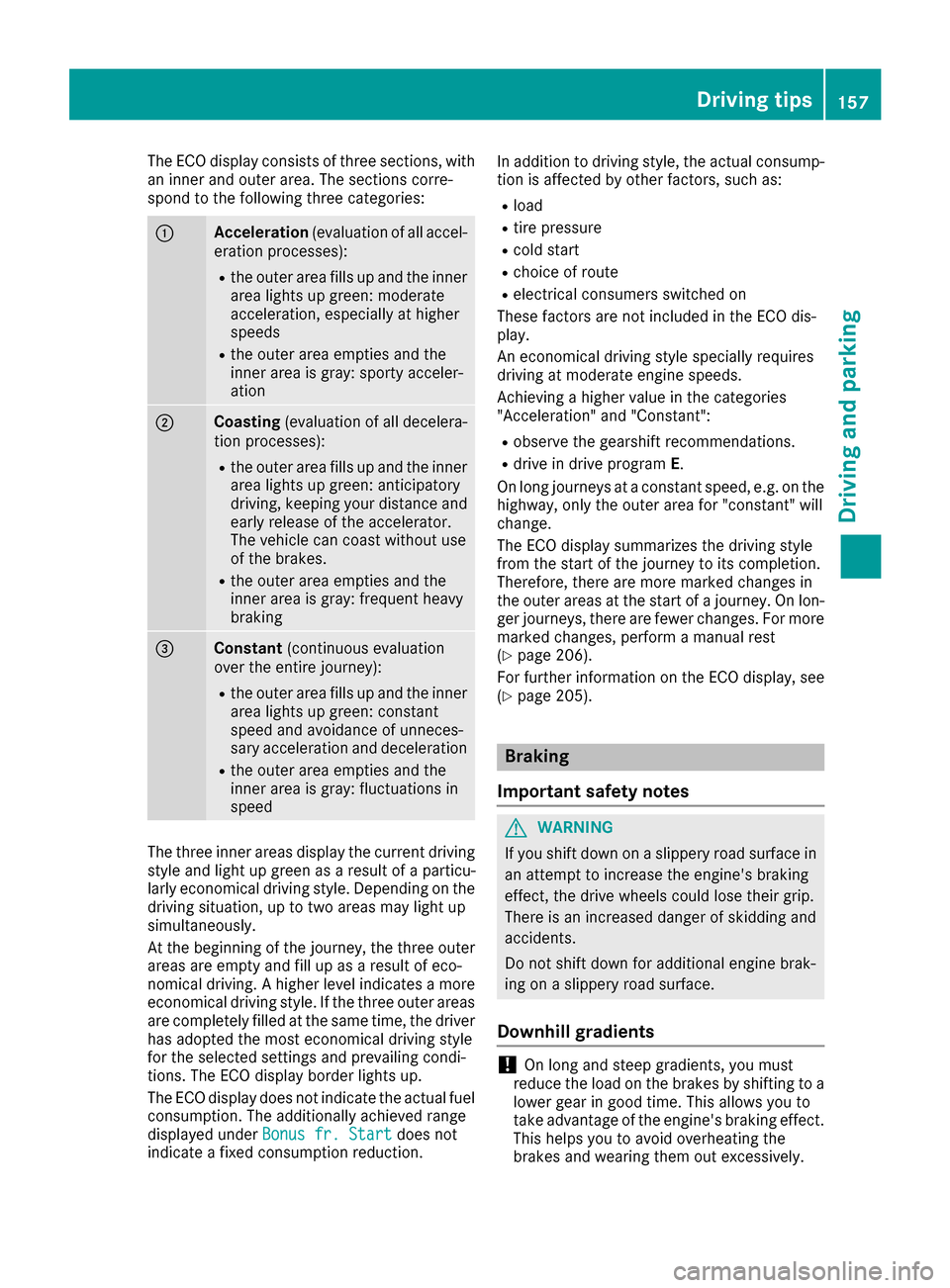
The ECO display consistsofthree sections, with
an inner and outer area. The section scorre-
spond to the following three categories:
:Acceleration (evaluation of all accel-
eration processes):
Rthe outer area fills up and the inner area lights up green: moderate
acceleration ,especially at higher
speeds
Rthe outer area empties and the
inner area is gray: sporty acceler-
ation
;Coasting (evaluation of all decelera-
tion processes):
Rthe outer area fills up and the inner area lights up green: anticipatory
driving, keeping your distance and
early release of the accelerator.
The vehicle can coast without use
of the brakes.
Rthe outer area empties and the
inner area is gray: frequent heavy
braking
=Constant (continuous evaluation
over the entir ejourney):
Rthe outer area fills up and the inner
area lights up green: constant
speed and avoidance of unneces-
sary acceleration and deceleration
Rthe outer area empties and the
inner area is gray: fluctuations in
speed
The three inner areas display the current driving
style and light up green as aresult of aparticu-
larly economical driving style. Dependin gonthe
driving situation, up to two areas may light up
simultaneously.
At the beginning of the journey, the three outer
areas are empty and fill up as aresult of eco-
nomical driving. Ahigher level indicates amore
economical driving style. If the three outer areas
are completely filled at the same time, the driver
has adopted the most economical driving style
for the selected settings and prevailing condi-
tions. The ECO display border lights up.
The ECO display does not indicate the actual fuel consumption. The additionally achieved range
displayed under Bonus fr. Start
does not
indicate afixed consumption reduction. In addition to driving style, the actual consump-
tion is affected by other factors, such as:
Rload
Rtire pressure
Rcold start
Rchoice of route
Relectrical consumer
sswitched on
These factor sare not included in the ECO dis-
play.
An economical driving style specially requires
driving at moderate engine speeds.
Achievingah igher value in the categories
"Acceleration" and "Constant":
Robserve the gearshift recommendations.
Rdrive in drive program E.
On long journeys at aconstant speed, e.g. on the
highway, only the outer area for "constant" will
change.
The ECO display summarizes the driving style
from the start of the journey to its completion.
Therefore, there are more marked changes in
the outer areas at the start of ajourney. On lon-
ger journeys, there are fewer changes. For more
marked changes, perform amanual rest
(
Ypage 206).
For further information on the ECO display,s ee
(
Ypage 205).
Braking
Important safety notes
GWARNING
If you shift down on aslippery road surface in
an attempt to increase the engine's braking
effect,t he drive wheels could lose their grip.
There is an increased danger of skidding and
accidents.
Do not shift down for additional engine brak-
ing on aslippery road surface.
Downhill gradients
!On long and steep gradients, you must
reduce the load on the brakes by shiftin gtoa
lower gear in good time. This allows you to
take advantage of the engine's braking effect.
This helps you to avoid overheating the
brakes and wearing them out excessively.
Driving tips157
Driving and parking
Z
Page 160 of 354
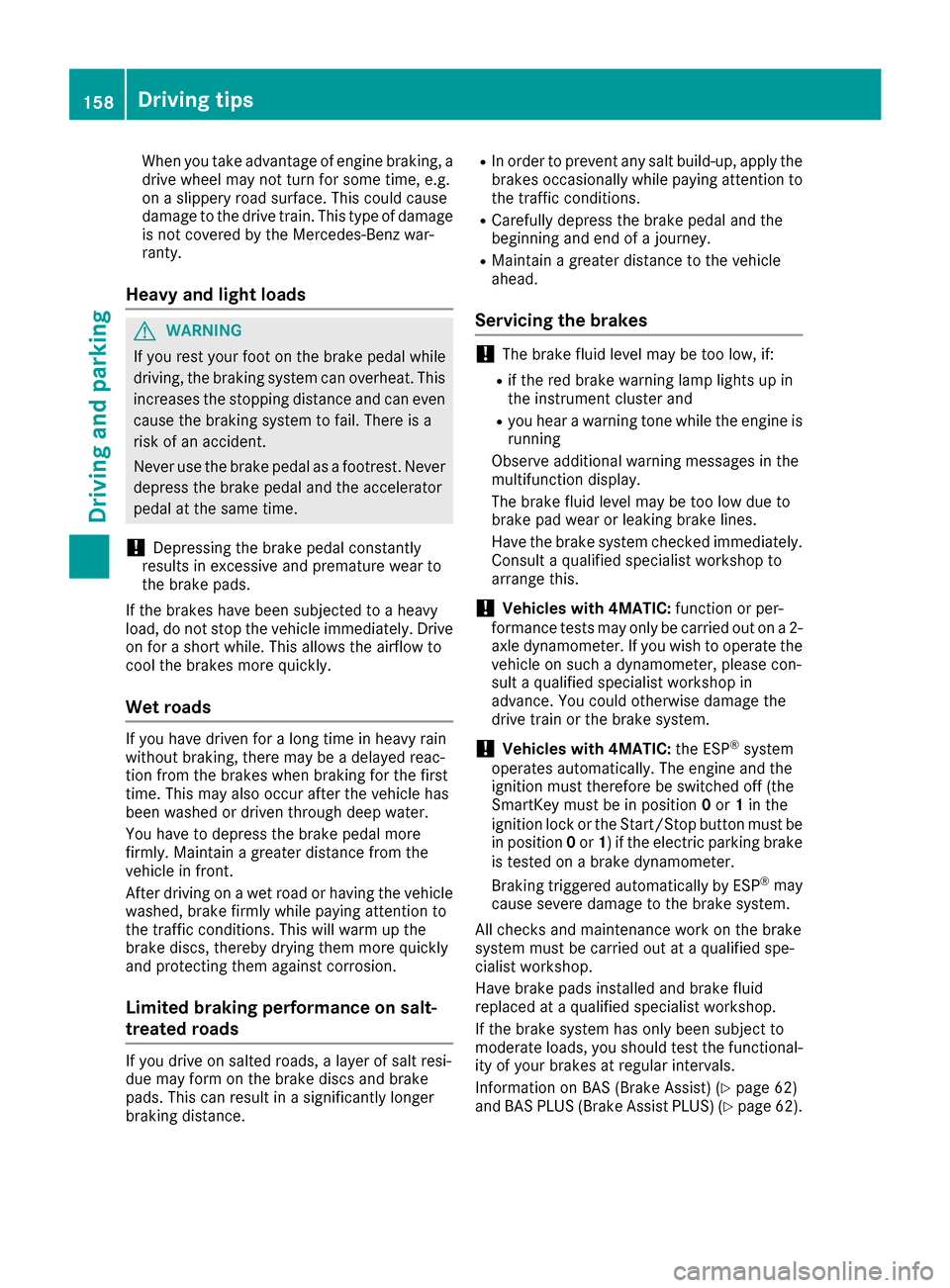
When you take advantage of engine braking, a
drive wheel may not turn for some time, e.g.
on aslippery road surface. This could cause
damage to the drive train. This type of damage is not covered by the Mercedes-Benz war-
ranty.
Heavy and light loads
GWARNING
If you rest your foot on the brake pedal while
driving, the braking system can overheat. This increases the stoppin gdistanc eand can even
cause the braking system to fail. There is a
risk of an accident.
Never use the brake pedal as afootrest. Never
depress the brake pedal and the accelerator
pedal at the same time.
!Depressin gthe brake pedal constantly
results in excessive and premature wear to
the brake pads.
If the brakes have been subjected to aheavy
load, do not stop the vehicle immediately. Drive
on for ashort while. This allows the airflow to
cool the brakes more quickly.
Wet roads
If you have driven for along time in heavy rain
without braking, there may be adelayed reac-
tion from the brakes when braking for the first
time. This may also occur after the vehicle has
been washed or driven through deep water.
You have to depress the brake pedal more
firmly. Maintain agreater distanc efrom the
vehicle in front.
After driving on awet road or having the vehicle
washed, brake firmly while paying attention to
the traffic conditions. This will warm up the
brake discs, thereby drying them more quickly
and protecting them against corrosion.
Limited braking performance on salt-
treated roads
If you drive on salted roads, alayer of salt resi-
due may form on the brake discs and brake
pads. This can result in asignificantly longer
braking distance.
RIn order to prevent any salt build-up, apply the
brakes occasionally while paying attention to
the traffic conditions.
RCarefully depress the brake pedal and the
beginnin gand end of ajourney.
RMaintain agreater distanc etothe vehicle
ahead.
Servicing the brakes
!The brake fluid level may be too low, if:
Rif the red brake warning lamp lights up in
the instrument cluster and
Ryou hear awarning ton ewhile the engine is
running
Observe additional warning messages in the
multifunction display.
The brake fluid level may be too low due to
brake pad wear or leaking brake lines.
Have the brake system checked immediately. Consult aqualified specialist workshop to
arrange this.
!Vehicles with 4MATIC: function or per-
formance test smay only be carried out on a2-
axle dynamometer. If you wish to operate the
vehicle on such adynamometer, please con-
sult aqualified specialist workshop in
advance. You could otherwise damage the
drive train or the brake system.
!Vehicles with 4MATIC: the ESP®system
operates automatically. The engine and the
ignition must therefore be switched off (the
SmartKey must be in position 0or 1in the
ignition lock or the Start/Stop button must be
in position 0or 1)ift he electric parking brake
is tested on abrake dynamometer.
Brakin gtriggered automatically by ESP
®may
cause severe damage to the brake system.
All checksa nd maintenance work on the brake
system must be carried out at aqualified spe-
cialist workshop.
Have brake pads installed and brake fluid
replaced at aqualified specialist workshop.
If the brake system has only been subject to
moderate loads, you should test the functional-
ity of your brakes at regular intervals.
Information on BAS (Brake Assist )(
Ypage 62)
and BAS PLUS (Brake Assist PLUS) (Ypage 62).
158Driving tips
Driving and parking